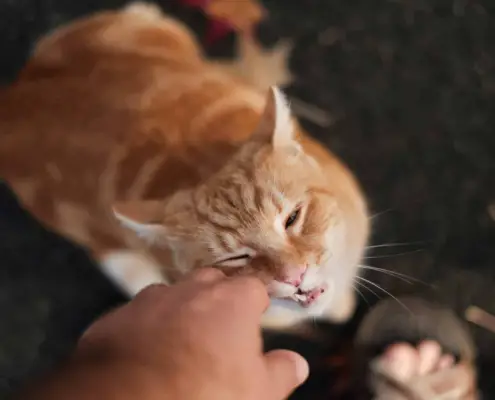
Cats have a unique way of showing affection and marking their territory – rubbing against legs. This behavior is often seen as endearing, but have you ever wondered why cats do this? In this article, we will delve into the psychology behind cats rubbing against legs and explore the hidden language they use to communicate with us.
The instinctual behavior of cats
Cats are highly instinctual animals, and rubbing against legs is a natural behavior rooted in their evolutionary past. By rubbing their scent onto objects or people, cats are marking their territory and establishing a sense of ownership. This behavior is particularly prominent in unneutered cats, as they have more active scent glands.
Communication through scent marking
Scent is an essential part of feline communication. Cats have scent glands located on various parts of their bodies, including their cheeks, chin, and paws. When a cat rubs against your legs, they are transferring their scent onto you as a way of marking you as part of their territory. It’s their unique way of saying, “You belong to me.”
The meaning behind cats rubbing against legs
When a cat rubs against your legs, it’s not just about marking territory. It’s also a sign of trust and affection. By rubbing against you, your cat is displaying a level of comfort and familiarity. It’s their way of saying, “I trust you, and I feel safe with you.” It’s a bonding behavior that strengthens the human-feline relationship.
The psychology of cats rubbing against legs
The act of rubbing against legs is not only instinctual but also serves a psychological purpose for cats. It helps them feel secure in their environment by leaving their scent on familiar objects and people. This behavior also releases endorphins, which have a calming effect on cats, reducing stress and anxiety. By rubbing against your legs, your cat is seeking comfort and reassurance.
Benefits of cats rubbing against legs
Cats rubbing against legs can have numerous benefits for both cats and their human companions. For cats, it helps them establish a sense of territory, reduce stress, and feel more secure in their environment. For humans, it’s a way to bond with their feline friends and experience the joy of a loving and affectionate pet. It can also have therapeutic effects, as the act of petting and interacting with a cat has been shown to reduce blood pressure and promote relaxation.
Common misconceptions about cats rubbing against legs
There are some common misconceptions about cats rubbing against legs that need to be addressed. One of them is that cats rub against legs solely for attention. While attention may be a factor, the primary reason for this behavior is marking territory and expressing affection. Another misconception is that all cats rub against legs. While it is a common behavior, not all cats exhibit this behavior, as it can vary depending on the individual cat’s personality and upbringing.
How to interpret your cat’s behavior
Understanding your cat’s behavior can help you interpret their actions and strengthen your bond with them. When your cat rubs against your legs, observe their body language. If they are relaxed and purring, it’s a sign of contentment and trust. However, if they seem tense or exhibit aggressive behavior, it’s best to give them space and avoid handling them until they feel more comfortable.
Tips for encouraging positive interactions with your cat
If you want to encourage positive interactions with your cat, there are a few things you can do. Firstly, provide them with a safe and enriched environment that includes scratching posts, toys, and hiding places. This will allow them to engage in natural behaviors and feel more secure. Secondly, spend quality time with your cat, playing, grooming, and interacting with them regularly. Finally, be patient and understanding, as each cat has their own unique personality and needs.
Conclusion
Cats rubbing against legs is a fascinating behavior that serves as a form of communication and a display of trust and affection. Understanding the psychology behind this behavior helps us interpret our cats’ needs and enhance our relationship with them. So the next time your cat rubs against your legs, embrace the hidden language they are speaking and cherish the special bond you share.
If you enjoyed my article, I would appreciate you sharing it with your network.

Sima Ndlebe
Sima writes for CatBuzz. He is interested in Cats, Health and Fitness, and Entrepreneurship.
Published: 17 November 2023



